ColSebastianMoran
( IRL Richard Karash )
What about adapting a scanner lens for camera-scanning??
Why this might be of interest:
Here are the lenses I will examine:
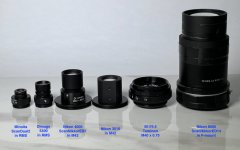
First the conclusions. For camera-scan of 35mm to FF body at 1x:
I highly recommend these for excellent results, highest resolution, clean to corners, with results equal to the excellent 70 f/2.8 Sigma Macro ART
- Nikon 8000 scanner lens – Best resolution, very clean, fixed f/2.8 -> very narrow DOF
- Nikon 3510 scanner lens – Exc resolution, very clean, very hard to find
I recommend these with very good results, slightly less resolution
- Minolta ScanDual II lens – Very good, another bargain
- 50 f/4.5 Tominon (Polaroid MP-4 lens) – Very clean, bargain at $50
Less Good:
- Coolscan 4000 scanner lens – Exc center. Poor res and dark in corners. Doesn’t cover.
- Dimage 5400 lens – Exc center. Poor res, smearing, & CA in corners. Avoid for 1x.
For camera-scan of 35mm to APS body at 0.67x (that is, 1:1.5) the results change:
I highly recommend these for excellent results, highest resolution, clean to corners, equal to the 70 Sigma:
- 50 f/4.5 Tominon (Polaroid MP-4 lens) – Very clean, bargain at $50
- Dimage 5400 lens – Top results, very clean
- Nikon 3510 scanner lens – Top results, very clean, very hard to find
Good, not quite as good as above:
- Minolta ScanDual II lens – Very good, some corner CA
Not Recommended:
- Coolscan 4000 scanner lens – Exc center, but doesn’t cover to corners.
Details in replies below. Or, jump to summary here.
Why this might be of interest:
- Lenses highly corrected (some would be APO for real, some corrected all the way to IR)
- Specifically designed for imaging a 24x36mm subject (the frame on 35mm film)
- Might want a dedicated setup for camera-scan that doesn’t use your regular lenses
- Might be inexpensive.
- Scanner lenses are designed for specific magnifications, will they work at the magnification ratios we want for camera-scanning (either 1x for FF or 0.67x for APS bodies)
- The image circle of a typical scanner won’t work for camera-scanning. In the scanner, the image is recorded on a line sensor as the film moves past the lens, so for most scanners the lens only has to cover 24mm wide. For camera-scanning, we are imaging the whole 35mm frame, 24x36mm, requires an image circle 43mm wide. Will these lenses covers a wider image circle than was needed in the scanner. CoolScan 9000, Nikon 3510, and Tominon lenses should cover 35mm, no problem
- Mounting. Most have no threads or have strange threads. Adapters are available and there are good jury-rigged solutions.
- No iris, so you’ll be using the full aperture of the scanner lens as the designer intended. You’ll get the full resolution of the lens design, but depth-of-field might be small, and you have no adjustment. Small DOF is a challenge for alignment and for film flatness.
- Focusing will be manual. And, you’ll need to get the lens at the right distance from the sensor using just the right extensions, a helicoid extension tube, a bellows, or other means.
Here are the lenses I will examine:

First the conclusions. For camera-scan of 35mm to FF body at 1x:
I highly recommend these for excellent results, highest resolution, clean to corners, with results equal to the excellent 70 f/2.8 Sigma Macro ART
- Nikon 8000 scanner lens – Best resolution, very clean, fixed f/2.8 -> very narrow DOF
- Nikon 3510 scanner lens – Exc resolution, very clean, very hard to find
I recommend these with very good results, slightly less resolution
- Minolta ScanDual II lens – Very good, another bargain
- 50 f/4.5 Tominon (Polaroid MP-4 lens) – Very clean, bargain at $50
Less Good:
- Coolscan 4000 scanner lens – Exc center. Poor res and dark in corners. Doesn’t cover.
- Dimage 5400 lens – Exc center. Poor res, smearing, & CA in corners. Avoid for 1x.
For camera-scan of 35mm to APS body at 0.67x (that is, 1:1.5) the results change:
I highly recommend these for excellent results, highest resolution, clean to corners, equal to the 70 Sigma:
- 50 f/4.5 Tominon (Polaroid MP-4 lens) – Very clean, bargain at $50
- Dimage 5400 lens – Top results, very clean
- Nikon 3510 scanner lens – Top results, very clean, very hard to find
Good, not quite as good as above:
- Minolta ScanDual II lens – Very good, some corner CA
Not Recommended:
- Coolscan 4000 scanner lens – Exc center, but doesn’t cover to corners.
Details in replies below. Or, jump to summary here.
Last edited by a moderator:
ColSebastianMoran
( IRL Richard Karash )
How to evaluate these lenses for camera-scanning?
I'll use a 61MPx body for FF and 24MPx body for APS.
I'll use Vlad's Test Target which gives me resolution measures across the frame and shows common aberrations. This is Vlad's target, and I'll refer to the areas marked.
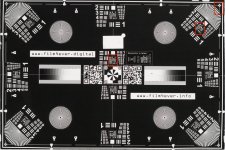
Why use this test target instead of the higher quality USAF 1951 glass target? Because this target is good enough for 60MPX sensors and because I can examine resolution across the whole frame with one shot.
Charts below show the measurement in lp/mm for each Group/Element. The left-hand chart from a 5x micro-photograph shows the quality of the target with resolvable detail at 87 lp/mm.
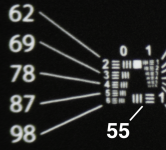
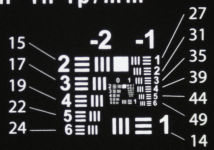
Criteria:
I'll use a 61MPx body for FF and 24MPx body for APS.
I'll use Vlad's Test Target which gives me resolution measures across the frame and shows common aberrations. This is Vlad's target, and I'll refer to the areas marked.

Why use this test target instead of the higher quality USAF 1951 glass target? Because this target is good enough for 60MPX sensors and because I can examine resolution across the whole frame with one shot.
Charts below show the measurement in lp/mm for each Group/Element. The left-hand chart from a 5x micro-photograph shows the quality of the target with resolvable detail at 87 lp/mm.


Criteria:
- Center resolution, but expect little difference between lenses here
- Corner resolution, clean image, contrast, and free of aberrations
- Clean image at very extreme corner to verify image circle covers the 35mm frame.
Last edited by a moderator:
ColSebastianMoran
( IRL Richard Karash )
Now for details:
All these lenses produce excellent results in the center, even to this 61MPx sensor. Below we see the results at 400% screen grabs. At left is one of the best lenses at 1x, to right a weaker lens. This lens/camera/target combination shows Group 0 Element 4, which is 78 lp.mm, plenty for camera-scanning of our film images. On the 61MPx sensor we are looking for G0-E3 or E4 69-78 lp/mm. On 24MPx sensors G0-E1 55 lp/mm. (Note: although similar to USAF 1951 target, the lp/mm measures are different.)
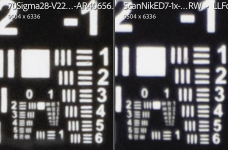
On left, the 70 Sigma, at right the CoolScan 4000 lens. These are representative of the results for the two groups of lenses. Center results are excellent for all these lenses at 1x to a 61MPx sensor.
Now look at corners, same lenses, again left is representative of the “Excellent” lenses, The two “Very Good” lenses will be slightly behind. The right is representative of the “Less Good” set with significantly poorer results in the corners.
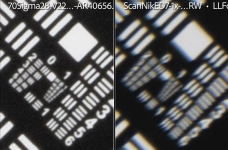
And next, at the extreme corner, the differences are clear. Here the Dimage 5400 is representative of the “Less Good” group; the CoolScan 4000 lens is worse.
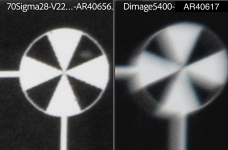
Next, we'll look to see if these differences, very visible at 400% magnification, will be visible in real images. And, then we'll examine results to APS bodies.
All these lenses produce excellent results in the center, even to this 61MPx sensor. Below we see the results at 400% screen grabs. At left is one of the best lenses at 1x, to right a weaker lens. This lens/camera/target combination shows Group 0 Element 4, which is 78 lp.mm, plenty for camera-scanning of our film images. On the 61MPx sensor we are looking for G0-E3 or E4 69-78 lp/mm. On 24MPx sensors G0-E1 55 lp/mm. (Note: although similar to USAF 1951 target, the lp/mm measures are different.)

On left, the 70 Sigma, at right the CoolScan 4000 lens. These are representative of the results for the two groups of lenses. Center results are excellent for all these lenses at 1x to a 61MPx sensor.
Now look at corners, same lenses, again left is representative of the “Excellent” lenses, The two “Very Good” lenses will be slightly behind. The right is representative of the “Less Good” set with significantly poorer results in the corners.

And next, at the extreme corner, the differences are clear. Here the Dimage 5400 is representative of the “Less Good” group; the CoolScan 4000 lens is worse.

Next, we'll look to see if these differences, very visible at 400% magnification, will be visible in real images. And, then we'll examine results to APS bodies.
Last edited by a moderator:
ColSebastianMoran
( IRL Richard Karash )
Now for a real image. Here's shot of the Duomo in Florence, shot with good prime lens, good light, good film. There is image detail and film grain across the whole image area. This film is mounted in conventional slide mount, and has some film curvature.
Here's the overall shot, with sampled areas marked:
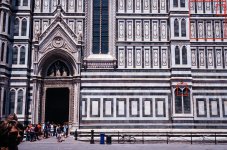
At 200% in the extreme corner, we can see visible differences in both grain and image detail between “Excellent” and “Less Good.”
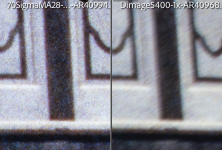
At 50%, differences are still visible.

Here is a comparison in mid corner at 200%. Clearly grain is less well resolved, but have we lost any image detail?
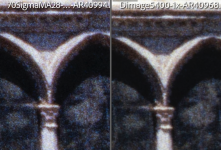
Here's the overall shot, with sampled areas marked:

At 200% in the extreme corner, we can see visible differences in both grain and image detail between “Excellent” and “Less Good.”

At 50%, differences are still visible.

Here is a comparison in mid corner at 200%. Clearly grain is less well resolved, but have we lost any image detail?

Last edited by a moderator:
ColSebastianMoran
( IRL Richard Karash )
Next installment will be to 24MPx APS body.
das
Well-known
Fantastic idea to use these types of lenses to scan negatives with a digital camera. However, it makes sense that some of these lenses aren't going to be ideal for a fixed digital camera shot as scanners will move all the way across a negative to minimize corner and illumination problems. The APS route seems promising as you are using the best part of the lenses to capture the image.
ColSebastianMoran
( IRL Richard Karash )
Fantastic idea to use these types of lenses to scan negatives with a digital camera. However, it makes sense that some of these lenses aren't going to be ideal for a fixed digital camera shot as scanners will move all the way across a negative to minimize corner and illumination problems. The APS route seems promising as you are using the best part of the lenses to capture the image.
Yes, at 1x to FF, it's a mixed bag. The highly rated Dimage 5400 and Coolscan 4000 lenses just don't cover. One possibility for 35mm is to use Dimage 5400 at 1x to APS and stitch 3 shots.
But, these four lenses do a good job at 1x to FF, two are bargains:
- Nikon 8000 scanner lens – Best resolution, very clean, fixed f/2.8 -> very narrow DOF
- Nikon 3510 scanner lens – Exc resolution, very clean, very hard to find
- Minolta ScanDual II or IV lens – Very good, another bargain
- 50 f/4.5 Tominon (Polaroid MP-4 lens) – Very clean, bargain at $50
APS next.
ColSebastianMoran
( IRL Richard Karash )
For camera-scan of 35mm to APS body at 0.67x (that is, 1:1.5) the results change.
Among the lenses in this test, I highly recommend for excellent results, highest resolution, clean to corners, results equal to the 70 Sigma and other excellent macro lenses:
- 50 f/4.5 Tominon (Polaroid MP-4 lens) – Tops. Very clean, bargain at $50
- Dimage 5400 lens – Top results, very clean, pricey
- Nikon 3510 scanner lens – Top results, very clean, very hard to find
- Minolta ScanDual II lens – Tops, very clean. Bargain.
Not Recommended:
- Coolscan 4000 scanner lens – Excellent center and top/bottom edge, but considerably weaker at L/R edge and corners.
The Minolta Scan Dual II is typical of the results in my recommend list. Note these are at 24MPx, Group 0 Element 1 55 lp/mm is an expected good result at 24MPx for both APS and FF sensors. At this quality, there should be no problem of image quality for enlargements from good film shots.
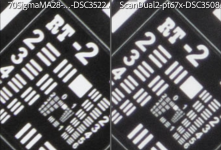
Here's the very extreme corner:
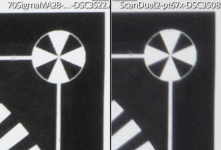
Now, we'll look at the Coolscan 4000 lens; does it cover? This lens has top resolution in the center but visibly poorer corners with lower resolution and darker. This lens was not designed to cover the needed image circle for cam-scan of 35mm to APS. Will be good for coins/stamps, but I would use a different lens for 35mm cam-scanning.
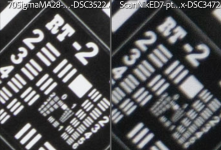
Among the lenses in this test, I highly recommend for excellent results, highest resolution, clean to corners, results equal to the 70 Sigma and other excellent macro lenses:
- 50 f/4.5 Tominon (Polaroid MP-4 lens) – Tops. Very clean, bargain at $50
- Dimage 5400 lens – Top results, very clean, pricey
- Nikon 3510 scanner lens – Top results, very clean, very hard to find
- Minolta ScanDual II lens – Tops, very clean. Bargain.
Not Recommended:
- Coolscan 4000 scanner lens – Excellent center and top/bottom edge, but considerably weaker at L/R edge and corners.
The Minolta Scan Dual II is typical of the results in my recommend list. Note these are at 24MPx, Group 0 Element 1 55 lp/mm is an expected good result at 24MPx for both APS and FF sensors. At this quality, there should be no problem of image quality for enlargements from good film shots.

Here's the very extreme corner:

Now, we'll look at the Coolscan 4000 lens; does it cover? This lens has top resolution in the center but visibly poorer corners with lower resolution and darker. This lens was not designed to cover the needed image circle for cam-scan of 35mm to APS. Will be good for coins/stamps, but I would use a different lens for 35mm cam-scanning.

Last edited by a moderator:
AgBr
Member
I can concur with your assessment of the 55mm micro-nikkors. I have tried both on aps-c and the 2.8 was better in the corners. I am now using a Zuiko 80mm 4.0 bellows lens that works better.
ColSebastianMoran
( IRL Richard Karash )
I am now using a Zuiko 80mm 4.0 bellows lens that works better.
Thanks. Yes, the Zuiko 80 f/4 Bellows lens is great at 1x. Should be good for camera scanning. Are you doing one-shot to APS at 1:1.5?
ColSebastianMoran
( IRL Richard Karash )
Checking a hunch: Neither the Dimage 5400 nor the CoolScan 4000 lens has enough image circle for 1x to FF body. But, perhaps will cover APS at 1x, then could be used for a three-shot stitch.
And here is the result. The Dimage 5400 lens will be fine in this application, 1x to 24MPx APS body, the stitch will give 50+MPx. The Coolscan 4000 lens will be a little rough in APS edges and corners.
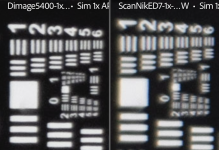
And here is the result. The Dimage 5400 lens will be fine in this application, 1x to 24MPx APS body, the stitch will give 50+MPx. The Coolscan 4000 lens will be a little rough in APS edges and corners.

ColSebastianMoran
( IRL Richard Karash )
Note that this page is about using scanner lenses.
I created another page here on RFF covering a wide range of macro, enlarging, and copy lenses for camera scanning.
I created another page here on RFF covering a wide range of macro, enlarging, and copy lenses for camera scanning.
AgBr
Member
I'm sorry for the post, I didn't realize that it was just for scanner lenses since you listed the micro Nikkors. If you want it moved to that thread I have no problem with that.
ColSebastianMoran
( IRL Richard Karash )
I'm sorry for the post, I didn't realize that it was just for scanner lenses since you listed the micro Nikkors. If you want it moved to that thread I have no problem with that.
No, no, no problem at all. We are all interested in these things!
AgBr
Member
I went to the other thread and looked there. Thanks for your hard work and time taken. I had always assumed that most of the scanner lenses would not have enough coverage to be of value. It looks like some are good. How about the old microfilm recording lenses?
AgBr
Member
And I see you found RAF camera. He has been a godsend for me.
ColSebastianMoran
( IRL Richard Karash )
How about the old microfilm recording lenses?
I have no experience, but I believe these have much different magnification ratios than we want for camera-scan. Ratios that would image a page to a microfilm. One lesson is to find lenses that are designed for the magnifications we want (1:1, 1:1.5 for 35mm, 1:2.25 for MF, etc.). Or some lenses that work in a wide range of magnifications (e.g. the 50 f/4.5 Tominon, the Sigma Macros).
ColSebastianMoran
( IRL Richard Karash )
Here's a table (PDF) of basic info on these scanner lenses, with links to references and to the adapters useful in mounting.
ColSebastianMoran
( IRL Richard Karash )
Summary
First, modern macros like the 70 Sigma Macro ART and many legacy macros are excellent. These scanner lenses are on a par or only slightly better at 50MPx, are harder to mount and use, and are less flexible. They are likely better corrected than our macro lenses, can be used for IR, and can make a nice dedicated digitizing setup.
The Tominon I’ve included is not a scanner lens. It is a superb macro lens unusual in that it performs at a wide range of magnifications from 1:5 to 1x to 5x. It performs over such a wide range because it is symmetrical. If interested in macro and/or camera-scanning, buy the 50 f/4.5 Tominon lens at $50. It’s a low priced gem.
Buy the Scan Dual II or IV lens for very good results to FF or APS, another low priced gem. Buy a parts-only scanner and extract the lens. Last saw at $50.
Buy the Dimage 5400 lens for superb results to APS body but not for one-shot to FF. Or use at 1x to APS and stitch. Robert O’Toole says this lens is the best he’s seen at 2x, and his review has boosted the price.
Buy the Coolscan 4000 lens for APS for excellent center sharpness. Can be great for coins and stamps, but it won’t cover the full 35mm image with quality in the useful camera-scanning configurations. Low priced.
Buy the Nikon 3510 lens for superb results in camera-scanning to either body, if and when you encounter one. This lens is very hard to find.
Buy the CoolScan 8000/9000 lens for the very best results to FF body, challenging to mount and narrow DOF makes it challenging to use, probably $600
First, modern macros like the 70 Sigma Macro ART and many legacy macros are excellent. These scanner lenses are on a par or only slightly better at 50MPx, are harder to mount and use, and are less flexible. They are likely better corrected than our macro lenses, can be used for IR, and can make a nice dedicated digitizing setup.
The Tominon I’ve included is not a scanner lens. It is a superb macro lens unusual in that it performs at a wide range of magnifications from 1:5 to 1x to 5x. It performs over such a wide range because it is symmetrical. If interested in macro and/or camera-scanning, buy the 50 f/4.5 Tominon lens at $50. It’s a low priced gem.
Buy the Scan Dual II or IV lens for very good results to FF or APS, another low priced gem. Buy a parts-only scanner and extract the lens. Last saw at $50.
Buy the Dimage 5400 lens for superb results to APS body but not for one-shot to FF. Or use at 1x to APS and stitch. Robert O’Toole says this lens is the best he’s seen at 2x, and his review has boosted the price.
Buy the Coolscan 4000 lens for APS for excellent center sharpness. Can be great for coins and stamps, but it won’t cover the full 35mm image with quality in the useful camera-scanning configurations. Low priced.
Buy the Nikon 3510 lens for superb results in camera-scanning to either body, if and when you encounter one. This lens is very hard to find.
Buy the CoolScan 8000/9000 lens for the very best results to FF body, challenging to mount and narrow DOF makes it challenging to use, probably $600
shijan
Established
I can confirm your opinion about Dimage Scan 5400II lens. I took it from my old broken scanner and tested it with APS-C sensor and it always feels soft in the corners. It works better if turn lens upside down. First time i was thinking maybe something was off centered, but later i realized that it is just the lens itself. Also seems it is not a real softness but more like defocused corners due distortion and too short DOF. I can perfectly focus to the corners or to the center. But not both. Center is perfect. No CA no light reflections.
I was a little bit disappointed because expected it as perfect lens and invested in bellows and RAF adapters.
It works very well under more magnification, if stitch 35mm frame from 3 or more parts.
I also tested old Vega lens from photo enlarger and can't use it because it was very sensitive to direct light and always produce light reflections.
I also tested for fun few lenses from from flatbed scanners and they are mostly useless. Sharp but extremely wide angled and distorted image.
I was a little bit disappointed because expected it as perfect lens and invested in bellows and RAF adapters.
It works very well under more magnification, if stitch 35mm frame from 3 or more parts.
I also tested old Vega lens from photo enlarger and can't use it because it was very sensitive to direct light and always produce light reflections.
I also tested for fun few lenses from from flatbed scanners and they are mostly useless. Sharp but extremely wide angled and distorted image.
Share:
-
This site uses cookies to help personalise content, tailor your experience and to keep you logged in if you register.
By continuing to use this site, you are consenting to our use of cookies.
